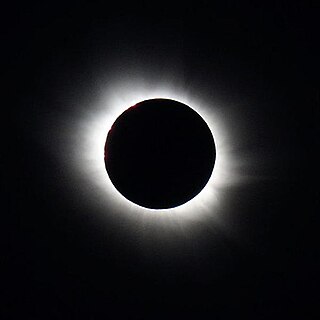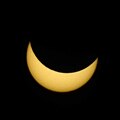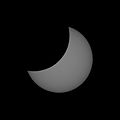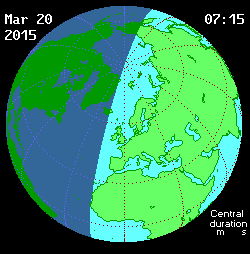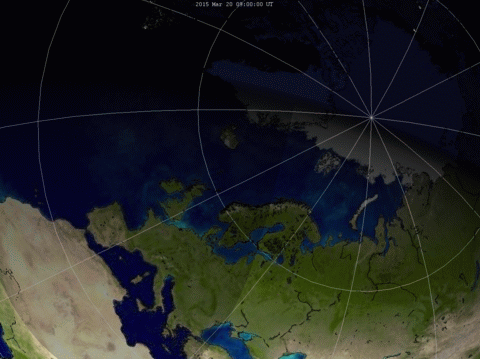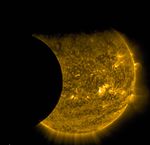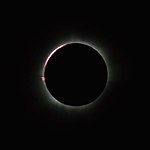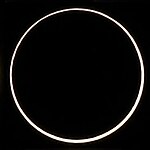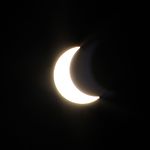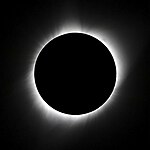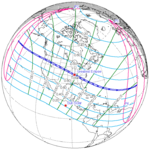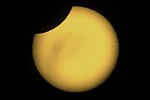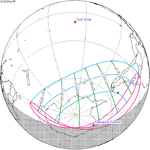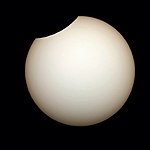21st-century total solar eclipse
A total solar eclipse occurred on March 20, 2015. A solar eclipse occurs when the Moon passes between Earth and the Sun, thereby totally or partly obscuring the image of the Sun for a viewer on Earth. A total solar eclipse occurs when the Moon's apparent diameter is larger than the Sun's, blocking all direct sunlight, turning day into darkness. Totality occurs in a narrow path across Earth's surface, with a partial solar eclipse visible over a surrounding region thousands of kilometres wide. This total solar eclipse is notable in that the path of totality passed over the North Pole. Totality was visible in the Faroe Islands and Svalbard.
It had a magnitude of 1.0445. The longest duration of totality was 2 minutes and 47 seconds off the coast of the Faroe Islands. It was the last total solar eclipse visible in Europe until the eclipse of August 12, 2026.[1]
The track of totality passed across the North Atlantic and into the Arctic Ocean.
Event
The solar eclipse began at 08:30 GMT in northwest Europe and moved towards the northeast but still in northern Europe. It was most visible from the North Atlantic and Arctic Oceans, Greenland, Iceland, Ireland, the United Kingdom, Faroe Islands, northern Norway and Murmansk Oblast. The shadow began its pass off the south coast of Greenland. It then moved to the northeast, passing between Iceland and the United Kingdom before moving over the Faroe Islands and the northernmost islands of Norway. The shadow of the eclipse was visible in varying degrees all over Europe.[2]
For example, London experienced an 86.8% partial solar eclipse while points north of the Faroe Islands in the Norwegian Sea saw a complete solar eclipse.[3] Three chartered airliners flew above the clouds, giving passengers a slightly prolonged view.[4]
The eclipse was observed at radio frequencies at the Metsähovi Radio Observatory, Finland, where a partial eclipse was seen.[5] The eclipse was also observed by meteorological satellite Meteosat-10.[6][7]
Impact
This section needs to be updated. Please help update this article to reflect recent events or newly available information. (May 2017)
The European Union has a solar power output of about 90 gigawatts and production could have been temporarily decreased by up to 34 GW of that dependent on the clarity of the sky. In actuality the dip was less than expected, with a 13 GW drop in Germany happening due to overcast skies.[8][9] This was the first time that an eclipse had a significant impact on the power system, and the electricity sector took measures to mitigate the impact. The power gradient (change in power) may be −400 MW/minute and +700 MW/minute. Places in Netherlands, Belgium and Denmark may be 85.2% obscured.[10][11] Temperature may decrease by 3 °C (5.4 °F), and wind power may decrease as winds are reduced by 0.7 m/s (2.3 ft/s).[12]
Coincidence of events
In addition to the eclipse, 20 March 2015 was also the day of the March equinox (also known as the spring or vernal equinox in the Northern Hemisphere). In addition, six supermoons were expected for 2015. The supermoon on 20 March 2015 was the third of the year; however, it was a new moon (near side facing away from the sun), and only its shadow was visible.[13]
At greatest eclipse, the Sun was at its zenith less than 24 kilometres (15 mi) south of the Equator. Greatest eclipse occurred at 09:45:39 UTC of Friday, March 20, 2015 while March Equinox occurred at 22:45:09 UTC, just under 13 hours after the greatest eclipse (Greatest eclipse occurred in winter, 13 hours before spring).
Religious Significance
Proponents of the Blood Moon Prophecy, such as Bob O'Dell[14] also pointed out that 20 March 2015 was also a significant day on the Jewish and Biblical calendar. That evening was the onset of the Hebrew month of Nisan, the first month in the Biblical calendar year. Furthermore, the path of the total eclipse over the North Pole[15] was a highly symbolic location infusing the day with both great natural significance and profound religious meaning according to O'Dell. Due to the significance of the eclipse, a global prayer event in Jerusalem was organized that day.[16]
Eclipse visibility
The event was visible as a partial eclipse all across Europe including: Norway, Sweden, Denmark, the United Kingdom,[17] Ireland,[18] Portugal, France,[19] Germany,[20] Poland,[21] Czech Republic, Slovakia, Hungary, Austria, Italy, Montenegro, Finland, Western Russia, and Ukraine.
-
Sheffield, United Kingdom. All time local time (GMT)
-
Lorient, France, 10:20 local time (9:20 GMT)
-
Berlin, Germany, 10:29 local time (9:29 UTC) – unconfirmed source
-
-
-
Chester-le-Street, United Kingdom, 9:36 GMT
-
Tórshavn, Faroe Islands, End of totality, 9:43 local time (GMT)
-
Wrocław, Poland, 10:44 local time (9:44 UTC)
-
Hjartdal, Norway, 10:47 local time (9:47 UTC)
-
Prague, Czech Republic, 10:49 local time (9:49 UTC)
-
Kłodzko, Poland, 10:54 local time (9:54 UTC)
-
Warsaw, Poland, 10:56 local time (9:56 UTC)
-
Budapest, Hungary, 11:00 local time (10:00 UTC)
-
Bregenz, Austria, 11:06 local time (10:06 UTC)
-
Milan, Italy, 11:08 (10:08 UTC) – unconfirmed source
-
Petrozavodsk,
Russia, 13:25 local time (10:25 UTC)
-
Kiev, Ukraine, 12:28 local time (10:28 UTC)
-
Ulcinj,
Montenegro, 11:34 local time (10:34 UTC)
-
Moscow, Russia, 13:35 local time (10:35 UTC)
-
Simulation
Related eclipses
Eclipses of 2015
Solar eclipses descending node 2015-2018
Lunar eclipses
A total lunar eclipse followed on April 4, 2015, visible over Australia, and the Pacific coast of Asia and North America.[22]
Solar eclipses 2015–2018
This eclipse is a member of a semester series. An eclipse in a semester series of solar eclipses repeats approximately every 177 days and 4 hours (a semester) at alternating nodes of the Moon's orbit.[23]
Partial solar eclipses on July 13, 2018, and January 6, 2019, occur during the next semester series.
Saros series
This eclipse is a part of Saros cycle 120, repeating every 18 years, 11 days, containing 71 events. The series started with partial solar eclipse on May 27, 933 AD, and reached an annular eclipse on August 11, 1059. It was a hybrid event for 3 dates: May 8, 1510, through May 29, 1546, and total eclipses from June 8, 1564, through March 30, 2033. The series ends at member 71 as a partial eclipse on July 7, 2195. The longest duration of totality was 2 minutes, 50 seconds on March 9, 1997. All eclipses in this series occurs at the Moon’s descending node.
| Series members 55–65 occur between 1901 and 2100
|
| 55
|
56
|
57
|

January 14, 1907
|

January 24, 1925
|

February 4, 1943
|
| 58
|
59
|
60
|

February 15, 1961
|
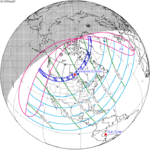
February 26, 1979
|
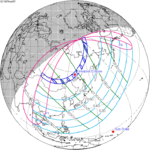
March 9, 1997
|
| 61
|
62
|
63
|
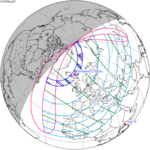
March 20, 2015
|

March 30, 2033
|
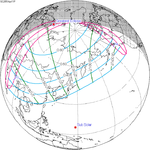
April 11, 2051
|
| 64
|
65
|

April 21, 2069
|
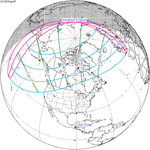
May 2, 2087
|
Metonic series
The metonic series repeats eclipses every 19 years (6939.69 days), lasting about 5 cycles. Eclipses occur in nearly the same calendar date. In addition, the octon subseries repeats 1/5 of that or every 3.8 years (1387.94 days). All eclipses in this table occur at the Moon's descending node.
| 21 eclipse events between June 1, 2011 and June 1, 2087
|
| May 31 – June 1
|
March 19–20
|
January 5–6
|
October 24–25
|
August 12–13
|
| 118
|
120
|
122
|
124
|
126
|

June 1, 2011
|

March 20, 2015
|

January 6, 2019
|
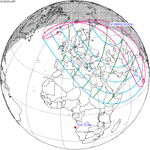
October 25, 2022
|
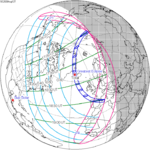
August 12, 2026
|
| 128
|
130
|
132
|
134
|
136
|

June 1, 2030
|
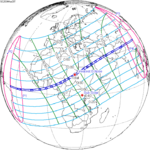
March 20, 2034
|
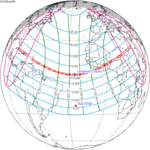
January 5, 2038
|

October 25, 2041
|
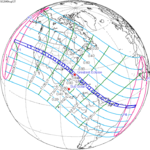
August 12, 2045
|
| 138
|
140
|
142
|
144
|
146
|

May 31, 2049
|

March 20, 2053
|

January 5, 2057
|

October 24, 2060
|

August 12, 2064
|
| 148
|
150
|
152
|
154
|
156
|
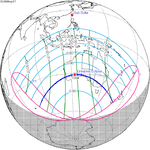
May 31, 2068
|

March 19, 2072
|

January 6, 2076
|
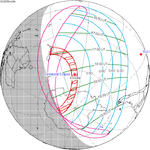
October 24, 2079
|
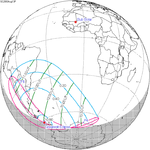
August 13, 2083
|
| 158
|
160
|
162
|
164
|
166
|

June 1, 2087
|
|
|

October 24, 2098
|
|
